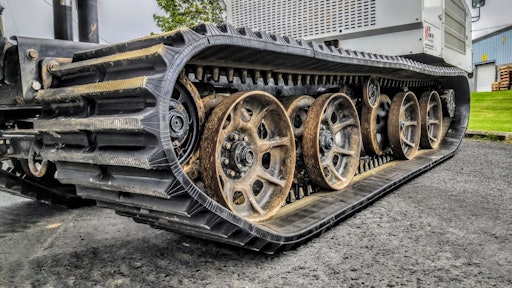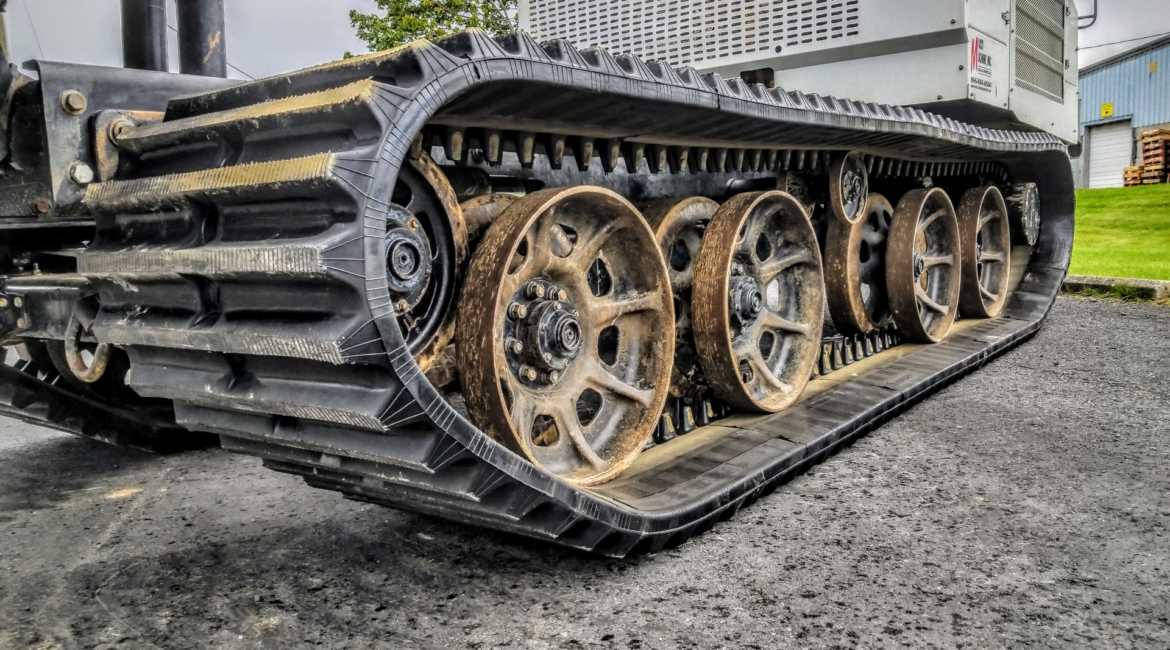Picture this: you’re cruising along in your skid steer, getting the job done with ease. But over time, you start to notice some wear and tear on your skid steer tracks. Well, fear not! In this guide, we’ll reveal the secret sauce to extend the life of your skid steer tracks. And no, it doesn’t involve a magic spell or expensive equipment upgrades.
So, how can you keep those tracks in tip-top shape? It’s all about maintenance and a little know-how. Whether you’re a pro skid steer operator or a curious beginner, we’ve got you covered. From proper cleaning techniques to smart usage tips, we’ll spill all the beans. Get ready to uncover the secrets to maximize the lifespan of your skid steer tracks like a true pro!
Ready to take your skid steer track game to the next level? We’ve got the insider knowledge you need. By the end of this guide, you’ll be armed with the skills to make your tracks go the extra mile and save some serious cash. So, let’s get started and unlock the long-lasting power of your skid steer tracks!
Here’s a simple guide to help you maximize the lifespan of your skid steer tracks:
- Maintain Proper Tension: Regularly inspect and adjust the tension of your tracks to prevent excessive wear.
- Clean Them Regularly: Remove debris and dirt from your tracks to avoid damage and improve traction.
- Avoid Overloading: Don’t exceed the recommended weight limits to prevent stress on the tracks.
- Choose the Right Terrain: Avoid rough or abrasive surfaces that can cause premature wear and tear.
- Inspect for Damage: Regularly check for signs of damage and address any issues immediately.
Follow these steps to ensure a longer lifespan for your skid steer tracks!

How to Extend the Life of Skid Steer Tracks: A Comprehensive Guide
In the world of heavy machinery, skid steer loaders are a popular choice for their versatility and maneuverability. However, the tracks that enable these machines to navigate various terrains can wear out over time. In this article, we will explore effective strategies to extend the lifespan of skid steer tracks, helping you reduce costs and optimize performance.
Understanding the Importance of Proper Maintenance
Regular maintenance is crucial to the longevity and performance of skid steer tracks. By implementing a comprehensive maintenance routine, you can significantly extend their lifespan. Here are some essential steps:
1. Clean Tracks Thoroughly
After every job or at the end of the day, make sure to clean the tracks thoroughly. Debris such as mud, gravel, and rocks can become embedded in the tracks and cause premature wear. Use a pressure washer or a hose with a high-pressure nozzle to remove the debris effectively. Be cautious not to damage any components while cleaning.
Pro Tip: Inspect the tracks carefully while cleaning. Look for signs of wear, cracks, or loose components. Early detection of any issues will allow for prompt repairs or replacements.
2. Check the Tension
The tension of the tracks is vital for optimal performance and longevity. Over time, the tracks can become loose, which can lead to excessive wear. Regularly check the tension and adjust it according to the manufacturer’s specifications. Consult the equipment manual for proper guidelines on tension adjustment.
Pro Tip: Ensure that the tension is evenly distributed across all the wheels. An imbalanced tension can cause uneven wear and affect the overall performance of the skid steer.
3. Lubricate the Tracks
To reduce friction and prolong the life of skid steer tracks, lubrication is essential. Apply a suitable lubricant to the pins, bushings, and other movable components. This will help minimize wear and prevent corrosion. Refer to the manufacturer’s recommendations for the appropriate type and frequency of lubrication.
Pro Tip: Clean the tracks before applying lubricant to ensure better adhesion and effectiveness.
Tips for Ensuring Longevity
In addition to regular maintenance, there are several other practices you can implement to extend the life of skid steer tracks:
1. Monitor Operating Conditions
Be mindful of the operating conditions that your skid steer tracks are exposed to. Avoid operating on sharp or abrasive surfaces that can cause excessive wear. If possible, choose smoother or less aggressive terrains to minimize track damage.
2. Practice Proper Operation Techniques
Improper operation techniques can put unnecessary stress on the tracks and lead to premature wear. Avoid sudden accelerations, high-speed turns, and excessive spinning of the wheels. These actions can cause tracks to wear out quickly.
Pro Tip: Take the time to train and educate equipment operators on proper operating techniques and the importance of track maintenance.
3. Invest in Quality Tracks
When it comes time to replace tracks, invest in high-quality options that are specifically designed for your skid steer model. Quality tracks are more durable and offer better resistance to wear and tear. They may have a higher upfront cost, but the long-term savings and performance benefits outweigh the initial investment.
Additional Tips and Best Practices
Alongside regular maintenance routines and mindful operation techniques, consider implementing the following tips:
1. Store Skid Steer Properly
When the skid steer is not in use, park it on a firm and level surface. This will prevent unnecessary stress on the tracks and reduce the risk of damage.
2. Regularly Inspect and Replace Wear Parts
Keep a close eye on wear parts such as rollers, sprockets, and idlers. These components can significantly impact the lifespan of your tracks. Replace worn-out parts promptly to prevent further damage.
Pro Tip: Opt for OEM or high-quality aftermarket parts to ensure compatibility and durability.
3. Consider Track Guards
In high-wear or heavy-duty applications, consider installing track guards to protect the tracks from potential damage. These guards act as a barrier against debris, rocks, and other hazards.
Maximizing the Lifespan of Skid Steer Tracks: Regular Maintenance and Care
To conclude, properly maintaining and caring for skid steer tracks is essential for their longevity and optimal performance. Implementing a comprehensive maintenance routine, practicing proper operation techniques, and investing in quality tracks are all effective ways to extend their lifespan. Regular inspection, prompt replacements, and considering additional protective measures will further contribute to maximizing the lifespan of your skid steer tracks. By following these strategies, you can reduce costs, improve efficiency, and ensure a smooth and seamless operation of your skid steer loader.
Key Takeaways: How to Extend the Life of Skid Steer Tracks?
- Regularly inspect tracks for wear and tear.
- Keep tracks clean and free from dirt and debris.
- Maintain proper tension in the tracks.
- Avoid excessive speed and rough terrain.
- Rotate tracks and alternate directions of travel.
Frequently Asked Questions
In this section, we will answer some common questions on how to extend the life of skid steer tracks and maximize their durability.
1. What are the best practices for maintaining skid steer tracks?
Proper maintenance is crucial for extending the lifespan of skid steer tracks. Regularly clean the tracks to remove debris and prevent excess wear. Inspect them for any damage or signs of wear, and replace any worn-out parts promptly. It’s also important to operate the skid steer within the specified load capacity to avoid overworking the tracks.
Furthermore, avoid operating the skid steer on rough or abrasive surfaces whenever possible, as this can significantly decrease the tracks’ lifespan. Finally, always follow the manufacturer’s recommendations for maintenance and servicing intervals to ensure optimal track performance.
2. Are there any preventive measures to reduce skid steer track wear?
Avoiding unnecessary turns and sudden maneuvers can help reduce wear on skid steer tracks. Whenever possible, try to steer using gradual movements instead of making sudden, jarring turns. Additionally, consider using rubber track pads or track shoes to provide extra protection against premature wear and tear.
Another preventive measure is to maintain proper track tension. Tracks that are too loose or too tight can experience increased wear. Consult the skid steer’s manual to determine the recommended track tension and adjust accordingly. Regularly inspect the tracks for signs of misalignment, and correct any issues promptly to prevent uneven wear.
3. Can the type of surface affect skid steer track lifespan?
Absolutely! The type of surface the skid steer operates on can have a significant impact on the lifespan of its tracks. Operating the skid steer on rough, abrasive surfaces such as rocky terrain or concrete can accelerate track wear. Whenever possible, try to avoid such surfaces or use track pads and shoes to provide extra protection.
On the other hand, operating the skid steer on softer surfaces such as soil or grass can be less damaging to the tracks. However, it’s still important to monitor the tracks for signs of wear and perform regular maintenance to ensure longevity.
4. Can overloading the skid steer cause damage to the tracks?
Yes, overloading the skid steer can cause significant damage to the tracks. Exceeding the skid steer’s load capacity puts excess strain on the tracks, leading to faster wear and potential track failure. Always follow the manufacturer’s load capacity guidelines and avoid overloading the machine to protect the tracks and ensure their longevity.
If you frequently work with heavy loads, consider upgrading to tracks specifically designed to handle higher weight capacities. These heavy-duty tracks can provide increased durability and overall longer lifespan.
5. Is there any regular maintenance required for skid steer tracks?
Yes, regular maintenance is vital for ensuring optimal performance and extending the life of skid steer tracks. Cleaning the tracks after each use helps prevent debris buildup, which can contribute to premature wear. Additionally, regularly inspect the tracks for any signs of damage, such as cuts, tears, or excessive wear.
It’s also essential to regularly check the tension of the tracks and adjust as necessary to maintain proper alignment. Lubricating the track joints and pivot points according to the manufacturer’s recommendations can also help reduce friction and improve longevity. Finally, follow the manufacturer’s servicing intervals for more extensive maintenance, such as track replacements or recommended wear part replacement.
How to Extend Track Life on Caterpillar Rubber-Track Loaders
Summary
Taking care of your skid steer tracks is important to extend their life. Here are some tips:
Regularly clean your tracks to remove dirt and debris that can cause damage.
Avoid driving over rough terrains and sharp objects that can puncture or tear the tracks.
Maintain proper tension in the tracks to prevent excessive wear and ensure a smooth operation.
Rotate the tracks periodically to distribute the wear evenly and extend their lifespan.
Inspect the tracks for any signs of damage and replace worn-out parts promptly.
By following these simple steps, you can extend the life of your skid steer tracks and save money in the long run. Keep your tracks in good condition, and they will serve you well for a long time!

